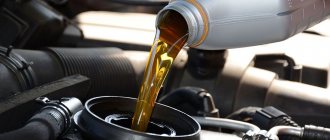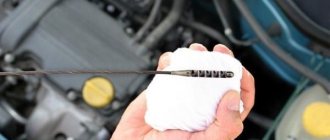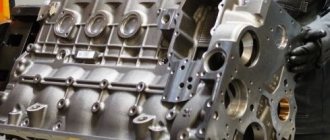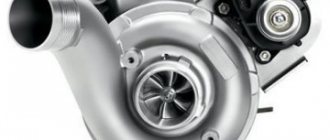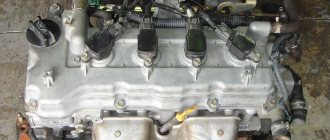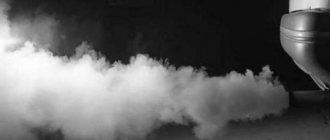Proper engine care is one of the most important tasks in car maintenance. Every owner who is attentive to his car knows that the performance of the car as a whole depends on the quality of service and functionality of the engine. Many car owners, when the time for scheduled maintenance of the car approaches, drive it to a service center, where specialists carry out all the necessary procedures in accordance with the regulations, however, there are also those who prefer to carry out simple service work on their own. In this article we will talk about the procedure for flushing the engine when changing the oil, the need for which has some controversy regarding the frequency of such a process and the type of flushing fluid. Let's consider whether flushing the engine with diesel fuel before changing the oil, which was used in ancient times and remains relevant today, is justified, let's talk about the advantages and disadvantages of this method of dealing with deposits in the power unit, and also tell you how to correctly carry out this procedure.
How to properly flush the engine before replacing diesel fuel.
Pros and cons of diesel fuel as a flushing fluid
There is an opinion that the quality of the function performed is superior to flushing liquids.
Due to its high wettability, diesel fuel (diesel fuel), dissolving the slags formed in the channels of the block, easily washes away the dirt accumulated there.
Automotive polyglots advise not to abandon the use of this method. This is motivated by the expediency of mixing diesel fuel with car oil in a 1:1 percentage ratio. In this case, the total displacement poured into the crankcase is observed. Using a cheap filter, you can begin the washing procedure, for which you need to stock up on standard motor oil, a new filter, and five liters of diesel fuel.
Is it necessary to wash the engine?
If good oil is poured into the engine, then there is no chance of deposits forming.
Diesel fuel or kerosene are indispensable cleaning agents for parts, assemblies, and a block, if they are disassembled and available for washing.
However, flushing the internal cavity of the engine clean is questionable. The cylinder block has channels, hard-to-reach labyrinths, from which it is difficult to remove diesel fuel used as a flushing liquid. So, you need to stock up on five liters of diesel fuel or kerosene and a filter (not expensive).
Mixed oil and diesel fuel in a ratio of 60/40
It is necessary to provide a high-quality filter and engine oil from the manufacturer, which will be filled in after washing the engine.
In what cases is flushing not required?
Clean engine
It is not necessary to flush the car engine when changing the oil using diesel fuel or specialized fluids from car dealerships in the following cases:
- when switching from synthetics to semi-synthetics;
- when changing from synthetic to synthetic;
- when pouring synthetics instead of mineral water.
As for situations in which flushing with diesel fuel or specialized compounds is mandatory, these include:
- replacing mineral oil with synthetic oil;
- after repair of the cylinder head;
- antifreeze or other coolant has gotten into the oil;
- you had to urgently fill in inexpensive or incorrectly marked oil;
- you do not know what oil was filled before you.
You can flush the engine not only when changing the oil, but also regularly every year for preventive purposes.
The process of flushing the engine with diesel fuel
The washing and replacement process is accompanied by the following steps:
- The engine warms up to operating temperature (80-90° C) and the remaining oil is drained through the crankcase hole. This is done on a cooled engine.
- The engine starts for 15-20 seconds, with a periodic increase in speed. The manipulation is repeated two or more times.
- Close the drain plug of the pan and add the remaining diesel fuel to the upper mark of the dipstick. This is done quickly in order to wash away clots of dirt from the channels and pan with a stream. It is not recommended to heat it above 50°C, giving it time to cool down. With this approach, dissolved deposits are removed with diesel fuel residues.
If contamination is visible to the naked eye, then the washing operation must be repeated several times.
A contaminated environment requires repeating the washing procedure many times at higher speeds, at which dirt is better removed . Viscous, stubborn deposits are removed by gradually increasing the oil pressure (3000 rpm). The option provides for a long service life. The process is completed by replacing the new filter with standard lubricant.
Upon completion of the work, the machine is operated in run-in mode for 2-4 days, without being subjected to heavy loads.
At the same time, there is no need for flushing if the car has only undergone servicing. That is, a car purchased at a car dealership - scheduled work was carried out at a service station. This is based on the removal of contaminants along with additives.
When flushing is not necessary
If you suspect that the engine is very dirty, it is better to clean it by hand, otherwise layers of dirt will foam and get into the clean engine oil
Flushing is not required in cases of replacement:
- Synthetics to synthetic lubricants.
- Synthetics to semi-synthetic oil.
- Mineral to synthetic.
When changing product manufacturers, since motor oils are the same in composition and are selected according to marking and class.
There is a need for flushing if:
- It is necessary to replace, for example, mineral oil with synthetic oil and vice versa.
Type of dirty engine:
- After completing the repair of the block, especially the head.
- There is no information about previously filled oil.
- The oil contains antifreeze, a different brand of fuel, and low quality oil.
The engine is washed no more than once a year, preferably when changing the oil.
Let's weigh the pros and cons
Of course, since you are reading the article, you are a caring owner. And at a minimum, try to extend the life of your engine - this will save money in the future on buying a new car or replacing an old one. But is the washing process really necessary? Will it do any harm?
Cases when major cleaning is necessary:
- The motor has considerable mileage. During long-term uninterrupted operation, clots consisting of tarry deposits, scale on the walls, and slag accumulate inside the power unit. The longer a car is used, the more consumables it has. If you want to extend its life, then rinse it.
- If you don’t know what’s in the box and don’t want to risk mixing possibly incompatible liquids
- In cases of change of manufacturers or types of fuels and lubricants. Without flushing, at best, you will get a lubricant with average properties that will behave unpredictably under extreme conditions. At worst, a breakdown of the lubrication system or the internal combustion engine as a whole.
- If there is a suspicion that cooling components have gotten into the oil when using the car. As a result of breakdowns of individual components.
- After a major overhaul of the “heart”. Due to such work, small particles of used lubricants or scattered scale may remain inside. Without flushing, they will worsen the passage of lubricant through the channels intended for this purpose.
- Using the machine for a long time under extreme conditions: low or high temperatures outside, high speeds, dusty or polluted operating environment
- Inside is a turbocharged engine, which is especially sensitive to dirty lubricant and can be seriously damaged. For such models, a “major bath” is required much more often - every 3-5 thousand km.
What to wash with?
Motor oils contain additives with detergent, anti-corrosion, antioxidant, and extreme pressure properties. They are not prone to the formation of deposits and dirt. Many of them are retained by the filter, and some are discharged through the crankcase drain hole. Deposits accumulate if different brands of oil are used.
That is, the remaining contaminants, mixing with the engine oil, precipitate, forming deposits. Frequent overheating of the engine leads to the formation of these, causing decomposition of the motor fluid. As a result, coke deposits that are difficult to wash off and sometimes cannot be removed appear on the inner walls of the block. The situation comes down to the rapid depletion of the lubricant life.
What's better
GZox Flushing Oil
It is preferable to use flushing fluids for the engine. Their range differs in additive components.
- FlushOil - is poured after draining the waste. It is recommended to operate the car for 50÷500 km before filling with new oil.
- EngineFlush - used after removing the old one. Can be added to the oil in the pan. It is advisable to let the machine idle for a few minutes.
- Cleaning additives are poured into the engine 3-4 days before replacement. They have the ability to penetrate everywhere, splitting and dissolving sludge and slag.
Result of using flushing fluid
Meanwhile, there is no consensus regarding flushing oils. Doubts are raised by aggressive (alkaline) additives, which unsatisfactorily clean coked deposits of dirt within a few minutes of engine operation. And aggressive compounds lead to corrosion of rubber seals.
Why is a heavy shower harmful to the engine?
On the other hand, there are a number of contraindications. Mainly depending on the cleaning procedure itself.
Engine washing is carried out in 3 stages:
- Removing used grease
- Filling the cleaner
- Draining the cleaning liquid
As a result of using a “diluted” lubricant, we have:
- Fast resource depletion
- Poor performance of the lubricating function
- The emergence of an emulsion
- Foaming lubricant and other “delights”
- Reducing viscosity is the main characteristic that a car enthusiast relies on when filling a new petroleum product.
Flaws
Cleaners or diesel fuel cannot completely remove deposits from the internal combustion engine due to the presence of hard-to-reach channels.
Result after manual washing. Using diesel fuel as a flushing liquid will not give this result.
For example, diesel fuel, being a fuel, does not dissolve slags and carbon deposits, but peels them off from the walls. These contaminants, which are not completely removed, circulate with fresh motor oil, impairing its beneficial properties. That is, exfoliated contaminants are poorly washed out completely when drained.
They pose a danger in that they clog lubrication channels and mesh, leading to decreased circulation and oil starvation of operating components . The use of flushing fluid with alkaline additives inevitably leads to damage to the rubber gaskets, oil seals, and seals. And this is a direct road to failure of the power unit.
The proverb “An old friend is better than two new ones” suggests itself. Or maybe diesel fuel is better than alkaline products.
KIA Ceed SW MT EX Oil Blue › Logbook › Flushing the engine with diesel fuel
The car drove 120 thousand and began to eat up oil (up to 1 liter per 1000 km). Compression in all pots is 12.5. Nothing is leaking anywhere. The exhaust is normal.
It was decided to first resort to budgetary methods to restore performance characteristics. To begin with, we decarbonized the rings twice using LAVR. The situation has improved slightly, consumption has decreased, but not enough (about 500 ml per 1000 km).
After thinking and reading materials on the Internet, we decided to test the hypothesis with coked oil scraper rings, which LAVR could not reach due to the fact that it was buried in the cylinders through spark plug wells. We decided to wash from below.
We drained the used oil and washed it with clean diesel fuel by gravity, without starting the engine. The solarium was the same color as a waste product.
Next, we drained 6 liters of the mixture (solar - flushing oil 1:1) and poured it into the engine for 1 hour, turning the crankshaft by hand several times. They started the engine and let it warm up to 40 degrees. They drained it, the liquid was again the color of waste. In addition, dark-colored crumbs were found at the bottom of the basin; the particle size reached 1 mm in thickness and 3 mm in length. The particles were not magnetic. These were probably fragments of “muck” that prevented the oil scraper rings from doing their job. When the trigger was pressed, white smoke came out of the chimney and soot flew.
The procedure was repeated 2 more times. Each time the liquid that was drained was dirty, but each time it became cleaner.
And finally, we washed it with flushing oil, letting the engine run for about 10 minutes. The oil that came out was slightly lighter than the dark Velkopopovets goat.
We changed the filter and filled it with Motul 5w40. So far the flight is normal. I drove 200 km, the level has not changed yet.
Consumables and related tools: 15 liters of diesel fuel 8 liters of flushing oil (if you repeat, take 12 liters, we didn’t have enough oil for the last body of water for a 1:1 ratio, so we used 1 liter of oil for 3 liters of diesel fuel) 2 oil filters 3.5 liters of synthetic motor oil 6 liters of foamy drink 4 hands 2 heads
At the same time, we also changed the A/C radiator and cleaned the cooling radiator of accumulated fur coats.
PS 10 km after the procedure, the engine started working, it turned out that when flushing the radiator, two spark plug wells and the coils in them were filled with water. When replacing the spark plugs, it turned out that the spark plugs had a fair amount of soot on them (the same as in the exhaust during flushing). Therefore, after carrying out the above procedure, replace the spark plugs. PPS The car is catalytic-free and has a flame arrester. Chipovana. I’m afraid to imagine how this procedure could affect the catalyst, proceed at your own peril and risk. The desired result was achieved; large investments in engine overhaul/replacement were avoided.
This is interesting: Why are there black dots on car windows?
UPDATE: I drove 800 km, the level has not changed, the oil is clean. In general, the flight is normal. UPDATE: in terms of oil consumption, it hasn’t gotten any better, but the engine has cleaned up. In general, I sold it with oil.
Toyota Corolla Fielder S 2005 1.8 MT Light Blue › Logbook › Flushing the engine with diesel fuel
I found information on the Internet that some people wash their engines with diesel fuel. I became interested and puzzled by the question of studying. Not a lot of information was found, but the more I read, the more I wanted to rinse, since the service before me was not very good.
The most informative article was Extreme Oil Change.
When I removed the valve cover to replace the gasket, I saw the condition of the engine inside, and there were no solid oil deposits, but everything was more or less normal:
After that I decided to wash it. And since there was a glut of oil, I decided to combine this with decoking.
So, the first stage was decoking with laurel. Everything was according to the instructions, on a warm engine I unscrewed the spark plugs, poured in the laurel, tightened the spark plugs and waited. I didn't wait long, just over an hour. During this time, the liquid was completely gone from two cylinders, and a little remained in two. He pulled it out with a syringe. Next, I covered everything with an old T-shirt:
Then I put everything back together and took off the gas. There wasn't much smoke.
Then came the actual washing process. There is no photo of the process, as I did everything in one place, covered in oil, it was not convenient to take photos. 1. Unscrew the drain plug and drain the oil from the engine. Black cocoa poured out. 2. I poured about a liter of diesel fuel into a wide-necked milk bottle and poured it into the engine. The diesel fuel washed away some dirt from the walls. 3. Tightened the drain plug and installed a new one
oil filter.
4. I poured 4 liters of a solution of 2.5 liters of oil + 1.5 liters of diesel fuel, pre-mixed. 5. Started the engine and let it run for 20-30 seconds. Then I turned it off and let it sit for a minute. The most important thing is not to let the engine get too hot. As a result, I did this several times, in total the engine ran for about 5 minutes with breaks to cool down. 6. Unscrewed the drain plug and drained the liquid from the engine. The poop that came out was almost the same black as the first time, only a little thinner! 7. I poured a liter of clean diesel fuel into the engine, and a liter of dirty diesel fuel flowed from below. 8. Tightened the drain plug and installed a new
oil filter.
9. I poured 4 liters of a solution of 2 liters of oil + 2 liters of diesel fuel, pre-mixed. 10. Approximately according to the same scheme as before, I let the engine run several times for 30 seconds. At this stage, I raised the speed several times to 2-2.5 thousand revolutions, for greater oil pressure in the system, in order to better flush it. 11. Unscrewed the drain plug and drained the liquid from the engine. The liquid that came out was not as thick as before, but still black. 12. I poured a liter of clean diesel fuel into the engine, and a liter of almost the same diesel fuel as I poured flowed down from below. 13. Tightened the drain plug and installed a new
oil filter.
14. I poured 4 liters of a solution of 1.5 liters of oil + 2.5 liters of diesel fuel, pre-mixed. 15. According to the already standard scheme, I let the engine run intermittently. This time with more frequent gas changes. I raised the speed several times to 3 thousand for a short time, kept it at 2 thousand for 20 seconds. 16. Unscrewed the drain plug and drained the liquid from the engine. Almost pure liquid has drained out. 17. Tightened the drain plug and installed a new
oil filter.
18. I filled in cheap oil and let the engine warm up to operating temperature and run for a while. The main purpose of this stage is to remove all remaining diesel fuel from the engine into the oil. Ideally, I would like to drive it for some time, but I did not have such an opportunity. 19. Unscrewed the drain plug and drained the oil from the engine. It drained out almost the same thing that was poured in. 20. Tightened the drain plug and installed a new
oil filter. 21. Filled with normal oil.
Here's what happened after each stage:
The main goal was to flush dirt out of the engine, and I think I achieved it. I didn’t expect any additional improvements, but it seemed that the engine became quieter. But this is more likely a placebo effect. For a couple of months the oil was not visible on the dipstick at all. Then it darkened a little and became more noticeable, but at the same time remained very clean.
This process has many nuances, I could have missed something, so if you want to repeat it, carefully study this issue on the Internet.
The main points that I noted for myself were a new oil filter every time and not to overheat the engine.
The washing solution can contain different proportions of oil and diesel fuel, even to the point that some are washed with pure diesel fuel. I used portions of 2.5m+1.5s, 2m+2s, 1.5m+2.5s with a gradual increase in the proportion of diesel fuel, because it was boring to pour a lot of diesel fuel at once.
I think we need to carry out the same procedure on the Mazda MX-5 Bomber 2.0 and Hyundai Accent Bomber, but my brother is not ready yet)))
Reviews from motorists who have tried the diesel fuel flushing method
Good reviews about the method of washing an engine with diesel fuel are mainly left by owners of outdated equipment. For example, drivers often wash ZMZ and VAZ engines with diesel fuel. Here, in most cases, there are no pronounced negative consequences. Although it is not a fact that in one wash the car owner did not reduce the engine life of thousands by 50 km.
You can also find negative reviews on the Internet. For example, after filling with diesel fuel, the engine seized. After disassembly, worn out and twisted liners were discovered.
Therefore, the conclusion about this method of cleaning the engine is this: you can use diesel fuel, but carefully and only on well-preserved outdated engines.
How to rinse the engine with diesel fuel before changing the engine oil
Flushing the engine before changing the engine oil is a procedure that drivers carry out for various reasons. The engine is flushed to remove heavy contaminants from the lubrication system, during the transition from one type of oil to another, as a result of malfunctions that intensively contaminate the oil system, etc. Note that there are several ways to clean the internal combustion engine. You can use special flushes into the used oil (the so-called “five-minute flushes”), add flushing oil for a short period of time, or even drive some flushes for several tens of kilometers in moderate mode.
In parallel with this, for many drivers, flushing the engine oil system with diesel fuel remains the preferred option. The main argument is that for such washing there is no need to separately purchase ready-made washing compositions, which saves money. In this article we will look at this cleaning method in more detail, and also talk about the advantages and disadvantages of such a solution.
Read in this article
Flushing the engine when changing oil with diesel fuel: pros and cons
Let's start with the fact that flushing the engine with diesel fuel is a well-known method of cleaning the internal combustion engine from contaminants, which has been actively used and continues to be used in the CIS by some owners of fairly old models of the domestic automobile industry. Before changing the oil, kerosene or diesel fuel is poured into both old trucks and special equipment, as well as into the power units of passenger cars produced by VAZ, GAZ, ZAZ, etc.
There are also car enthusiasts who practice this method on old foreign cars. Let us add that this washing method has both supporters and opponents. The first do not see any harm to the engine, others believe that after flushing with diesel fuel the engine loses its service life and may fail prematurely. Let's figure it out.
Otherwise, diesel fuel can be used to thoroughly clean a disassembled motor, for example, during a major overhaul, etc. It should be noted that this is where the widespread belief comes from that flushing the lubrication system with diesel fuel without disassembling the internal combustion engine also gives tangible results.
However, we should not forget that in the process of cleaning a disassembled engine, contaminants are simultaneously subjected to significant mechanical impact. In other words, kerosene or diesel fuel can partially dissolve toxins and carbon deposits, after which the dirt is removed manually. If you pour diesel fuel into the engine for flushing before changing the oil, then the effectiveness of this procedure can be considered questionable. Moreover, this flushing method may well be dangerous for the engine.
The fact is that any engine cleaners (both special means and diesel fuel) are not able to completely remove accumulated deposits, so it is impossible to completely flush the internal combustion engine. There are also a large number of hard-to-reach places in the lubrication system and in the engine itself. These areas usually contain the greatest amount of contaminants. If diesel fuel gets into the engine, the dirt does not dissolve, but simply flakes off. Next, the remaining diesel fuel or kerosene in the engine, which cannot be completely drained, is mixed with fresh engine oil, further deteriorating its properties.
As a result, some damage is caused to the engine; in some cases, the engine may fail completely. Let us add that at the same time various oil seals, gaskets and rubber seals suffer, which are also negatively affected by the flushing agent. This statement is true both for flushing with diesel fuel and in the case of using special products and flushing oils on dirty engines.
To wash or not to wash
There are plenty of both supporters and opponents of this event among iron horse owners. Of course, purely logically, flushing the system is a good thing.
However, is it necessary to flush the engine when changing the oil if the car, for example, has been in the hands of one owner since the moment of purchase, who constantly uses the same high-quality synthetics and replaces it strictly according to regulations or even earlier?
Most auto experts agree that flushing the lubrication system does not need to be done if several conditions are met:
- The car has been in the same hands since the start of operation.
- Regular maintenance schedules were not violated.
- During operation, fluids from different manufacturers were not added.
- The type of oil and its brand have not changed since the very beginning of operation.
If the car has had more than one owner and has an unusually opaque history of technical inspections, it is better to flush such an engine before changing the oil. You can check this offhand by unscrewing the oil filler neck and shining a flashlight under the valve cover.
If traces of fuel oil are visible to the naked eye, there is a violation of the lubricant change regulations. The verdict in this case is final - be sure to wash it. And the sooner the better.
How to wash the engine with diesel fuel or kerosene
In the event that you nevertheless decide to wash the power unit with diesel fuel, then it should be noted that this procedure is not complicated. Flushing the engine with diesel fuel before changing the oil is carried out as follows:
- It is necessary to prepare about 5-6 liters of pure diesel fuel/kerosene without impurities;
- Purchase 2 oil filters (one may be the cheapest);
- The engine warms up until it reaches operating temperatures;
- The used engine oil is drained and the old oil filter is removed;
- Next, you should fill in kerosene or diesel fuel, install a new (cheap) oil system filter;
- Then the engine should be started for a couple of minutes, slightly accelerated at idle to medium speed;
- Now you can turn off the car, since warming up the engine above 40-50 degrees with diesel fuel poured into the lubrication system is not allowed.
- After the internal combustion engine has cooled, the engine is started again and the procedure is repeated;
- Next, you can drain the diesel fuel, replace the oil filter and add fresh engine oil;
This is interesting: On the road, the traffic police inspector took a photo of my driver’s license. Does he have the right to do this and why did he do it?
Now let's look at the procedure in more detail. Note that some drivers do not fill the engine with pure kerosene or diesel fuel, but additionally dilute the cleaner with fresh engine oil. In this case, you will need to prepare 2-3 liters of affordable mineral water.
- Before draining used oil from the engine, it is necessary to either prepare a pan of increased capacity or have spare pans. The fact is that after draining the flush, as well as a number of additional manipulations, in general, twice as much liquid (old oil and flushing) will drain from the unit.
- After draining the “working off”, it is recommended not to screw in the drain plug, but to pour several liters of diesel fuel through the engine. The flush must be poured into the oil filler neck sharply so that the diesel fuel passes through the unit under a certain pressure and washes away the remaining engine oil. To do this you will need 2-3 liters of kerosene. After this, you can screw in the drain plug, after which diesel fuel is poured into the engine in a volume that almost reaches the “max” indicator on the dipstick.
After draining the flush, replacing the oil filter and adding fresh oil, you need to take into account that the engine may be difficult to start. The fact is that diesel fuel washes away the oil film and also does not have sufficient lubricating properties. As a result, it is difficult for the starter to turn the crankshaft. After starting the unit, you need to let the engine run for some time at idle speed. At the same time, you need to listen to the operation of the engine, to exclude the occurrence of extraneous noise, knocking or other suspicious sounds. After this, you can start using the car as usual.
Useful tips
Before draining the old oil, prepare a tray or basin of a suitable container to accommodate all the liquid. Do not rush to tighten the drain bolt into place after draining the flushing diesel fuel, but pour a few more liters through the system. Do this sharply to create a slight pressure that washes away any remaining oil. It is enough to pass three liters of diesel fuel in this way. Replace the drain bolt.
When the engine is running while flushing, you can rev it up a little, since as the speed increases, the pressure in the lubrication system increases. Thanks to this, the effectiveness of the cleansing procedure increases. The main thing is not to overdo it and do not allow the temperature to exceed 50 degrees.
When you drain the liquid, evaluate its condition for contamination. If the diesel fuel is noticeably dirty, you can repeat the washing. Also, before adding fresh oil, you can rinse 1-2 liters thoroughly without regret. In this way you will reduce the amount of diesel fuel residue in the block.
Please note that the first couple of starts, even with fresh oil, may be difficult. Diesel fuel washes away the oil film and has weak lubricating properties, making it more difficult for the starter to crank the crankshaft. When starting the engine, let it run for a while at idle and listen to its operation. There should be no extraneous sounds such as knocking or noise. Now you know how to flush an engine with diesel fuel - there is nothing difficult about it!
Video:
Video:
Video:
Video:
- Purpose of adding oil to diesel fuel
- What to do if engine oil leaks
- Why does the engine eat oil and how to find the problem?
- Increased engine oil consumption: what can be done?
- Methods for checking spark plugs on a diesel engine
- Engine overhaul
Show more
Click to cancel reply.
How to flush the engine with diesel fuel before changing the oil
Flushing the engine with diesel fuel before changing the oil is considered an old, but proven and practical method of cleaning the engine. It’s completely in vain that many modern car enthusiasts laugh at eccentrics who use this old-fashioned method.
Flushing the engine with diesel fuel will restore a second youth to the entire oil system.
Flushing with diesel fuel, i.e. diesel fuel, gasoline engine allows you to get rid of dirt and scale without the use of aggressive substances, and therefore without worrying about system elements that may be damaged by aggressive influence. Flushing the engine with diesel fuel allows you to restore a second youth to the entire oil system in a simple and cheap, and most importantly, safe way.
Summing up and conclusions
When washing the unit with diesel fuel, one small nuance should be taken into account. Unlike oil, diesel fuel is less viscous and does not provide the necessary adhesion to parts. When starting the engine during the washing process, minor problems with starting are possible - it may not start the first time.
Nowadays, various flushing compounds are offered for cleaning a car engine, but they are quite aggressive. A much gentler method is to wash the unit using diesel fuel. This method has been used for decades and has proven its effectiveness.
Features of the washing procedure
The operating principle of the engine lubrication system.
The main task of flushing the engine before adding new oil is to completely clean the system of previous fluid and accumulated dirt or carbon deposits. To solve this problem, it is necessary to use compositions that can dissolve solid growths, the remains of tarry deposits and the remains of the old composition. To clean the engine, 2 main methods are used: introducing special additives into the oil before draining it or pouring flushing fluid after draining the old composition. Modern means for this purpose cope well with the task, but, firstly, they are quite expensive, and, secondly, they have increased chemical aggressiveness, which can have a destructive effect on engine parts.
Diesel oil has been used as a flushing liquid since its appearance on the market. Moreover, in earlier times, when there were no special substances, diesel fuel, along with kerosene, was considered the best engine cleaner. This opinion of honored motorists is completely justified. Diesel fuel is a good solvent for many tarry residues and oily compounds. It has good fluidity and, passing through the oil channels of the system, is capable of dissolving toxins, dirt, scale, oil clots and bringing them out. In terms of its cleaning abilities, diesel fuel is a worthy competitor to modern flushing liquids. At the same time, it does not have any aggressive effect on metal, gaskets and seals. The reliability of the method of flushing the engine with diesel fuel has been tested over decades of operation of cars of various brands.
Experienced motorists who use the solar cleaning method recommend using a mixture of diesel fuel and oil. This mixture is prepared by mixing the ingredients equally. Similar to diesel fuel, engine cleaning is sometimes carried out using kerosene, which has a high dissolving ability in terms of its effect on oily and organic contaminants.
Positive effect and possible negative consequences
Diesel fuel has excellent dispersing ability. That is, it dissolves even old deposits of various natures, including sludge. Therefore, many motorists 20-30 years ago actively used diesel fuel as a liquid for flushing engines. That is, in those days when engine parts were massive with an impressive margin of safety and minimal requirements for fuels and lubricants.
In addition, some diesel fuel, which will certainly remain in the engine crankcase, will not have a pronounced negative effect on the new oil. After flushing the engine with diesel fuel, it is not necessary to somehow expel the remaining diesel fuel from the crankcase or to fill and drain fresh oil several times.
This method of cleaning the motor is also relatively inexpensive. Compared with cleaning agents, and even more so with specialized oils, washing the engine with diesel fuel will be several times cheaper.
This is where the positive aspects of this procedure end. Let's briefly look at the possible negative consequences.
- Lumpy detachment of solid deposits. Sludge build-up accumulates on static surfaces in many motors. Diesel oil can simply separate them from the surface and dump them into a pan. Or run it into the oil channel. Which will cause partial or complete blockage and oil starvation of any friction pair.
- Negative impact on rubber (caoutchouc) and plastic parts. The vast majority of modern seals and retainers in engines made of plastic and rubber are resistant to the chemical effects of any petroleum products. But diesel fuel can completely destroy “tired” non-metallic parts.
- Possible damage to the liners and the formation of scuffing in the ring-cylinder friction pairs. Diesel fuel does not have sufficient viscosity to create any strong protective layer.
All these consequences have the status of probable. And they will not necessarily occur in every individual case.
This is interesting: What to do if the engine knocks after turning off the ignition?
Carrying out the filling procedure
The engine is flushed with diesel fuel after draining the used oil. This draining is carried out in the standard way through a hole in the oil pan. To do this, the car is installed on an inspection hole or overpass. Using the appropriate wrench, loosen the drain plug. After a container is placed under it, the plug is unscrewed by hand and sharply pulled to the side so that the oil stream is directed into the container. Used oil must be completely drained from the system.
The next step is to remove the oil filter, which is usually unscrewed by hand. If necessary, the appropriate key is used. After this, a temporary oil filter is installed. It is only needed for the engine cleaning period, so it is recommended to choose the cheapest option.
The washing procedure is carried out in two stages. First, when the plug is removed from the drain hole of the oil pan, diesel fuel (a mixture of diesel fuel with oil or kerosene) is poured into the system with a sharp movement. The initial impulse of the priming jet is necessary to ensure gravity flow of the liquid throughout the system. The volume of diesel fuel poured is about 2.5-3.5 liters. The cleaner should pass through the oil system and flow out of the drain hole at the bottom. This ensures primary cleaning of the largest contaminants and residues of the old composition.
The next stage of washing is carried out with the plug closed, for which it is returned to its place and tightened manually. Diesel fuel is poured into the lubrication system in a volume equal to the usual amount of oil poured. After this, you need to start the car engine for a short time and drive it in the gas mode. The degree of cleaning of the system largely depends on this gas release from the engine. It is important to control the temperature - the engine should not warm up to operating temperature.
The engine is turned off and the drain plug is unscrewed again. All filled diesel fuel is drained while controlling the release of dirt. If pieces of dirt continue to come out along with the last drops of solvent, then the flushing operation is performed again (with the engine running). Similar procedures are carried out the required number of times. The duration is determined by the type of diesel fuel being drained.
Flushing stops when clean, transparent liquid begins to flow from the drain hole.
The engine flushing operation is completed by completely draining the flushing fluid. After which the drain plug is tightly screwed in with a key. The temporary oil filter is dismantled and a new high-quality oil filter is manually screwed in its place for operation under operating conditions. After all the manipulations have been completed, you can safely fill in new oil. Naturally, after filling in the new composition, it is necessary to carefully check the tightness of the entire system, and then carry out a test drive in the car.
The best flush for the engine cooling system
Flushing with water is well suited for the internal combustion engine cooling system. This method allows you to solve the problem quickly and at minimal cost.
It is recommended to use distilled water as it does not contain any aggressive substances that can damage rubber parts. This method is effective only in cases where the contamination is negligible.
The use of acids is more effective. This option involves the use of citric or phosphoric acid, which are diluted in distilled water in a proportion of 100 g per 1 liter.
Liquid poured into the cooling system remains there for at least three quarters of an hour. This procedure should be preceded by flushing with plain water, which is repeated after draining the acid from the system. The final rinse with water involves 4-5 full cycles to completely neutralize the acidic environment.
Car enthusiasts often resort to washing with a bite. In this case, an aqueous solution is formed in a proportion of 1 to 10. In order for the cleaning agent to function well, after pouring the solution into its system, it is heated to approximately 100 degrees Celsius.
After this, it is left in the system for about 10 hours. If, when draining the solution, there is no dirt and/or scale in it, then there was not enough time and the procedure should be repeated.
Washing with soda also finds its use, but exclusively for cleaning engine elements made of copper and/or brass. For these purposes, 50 grams of soda are diluted in a liter of plain water. This composition is cheap, but does the job perfectly.
